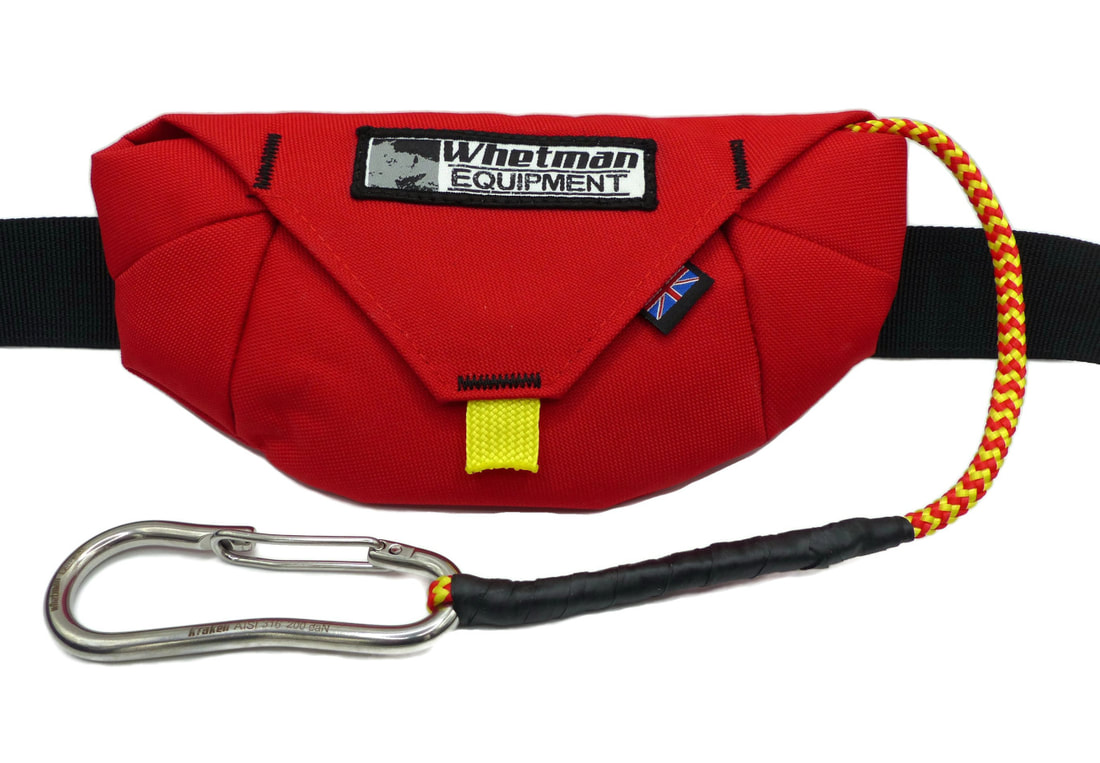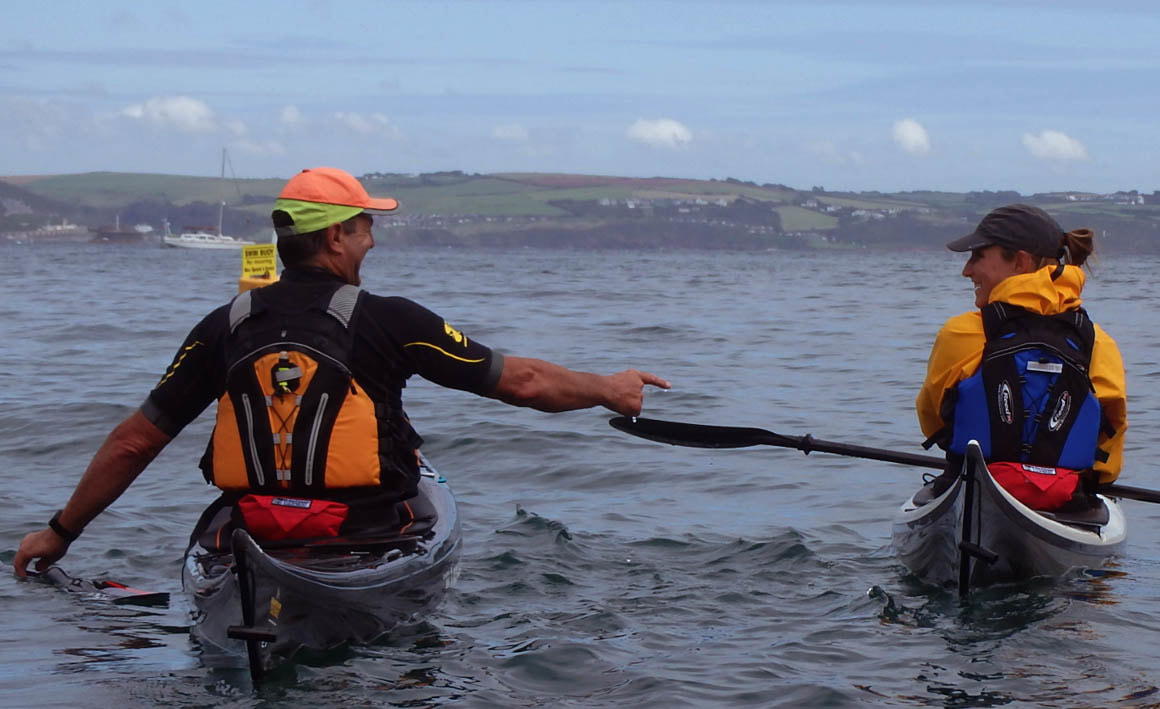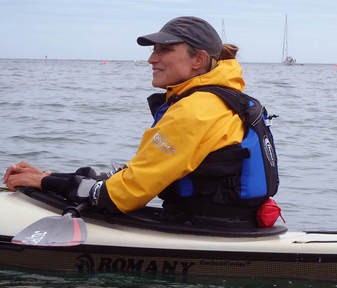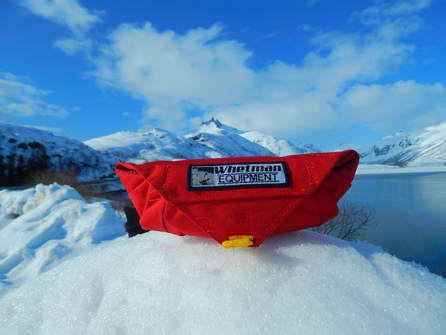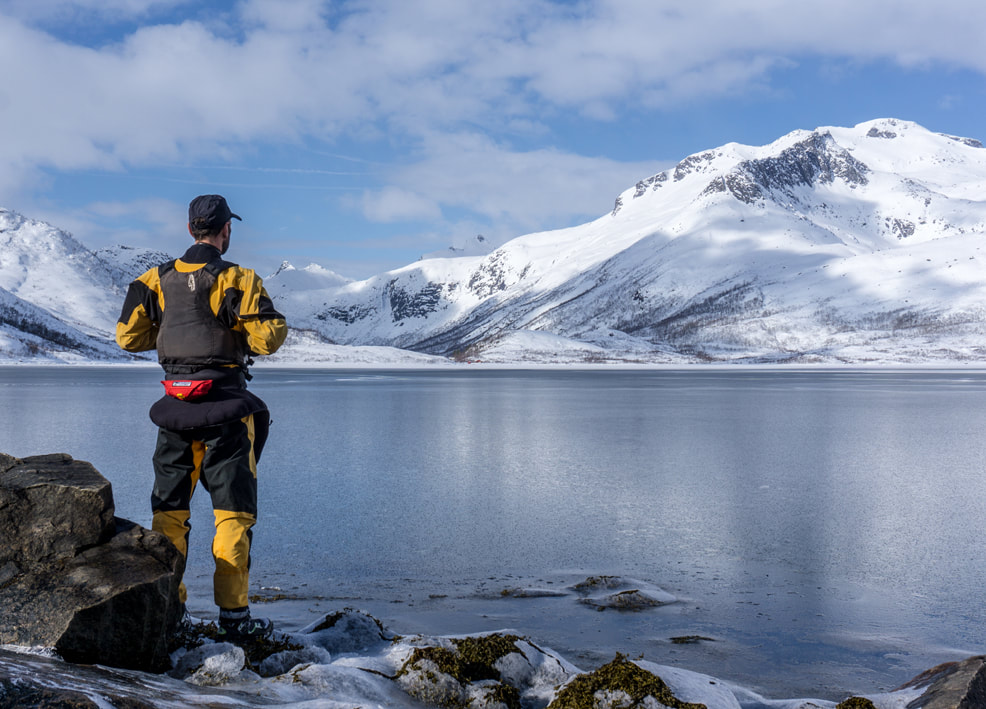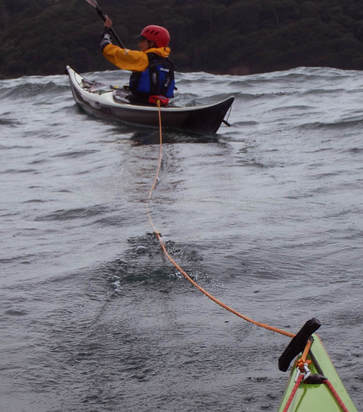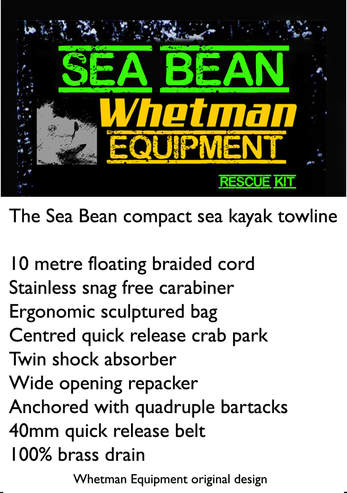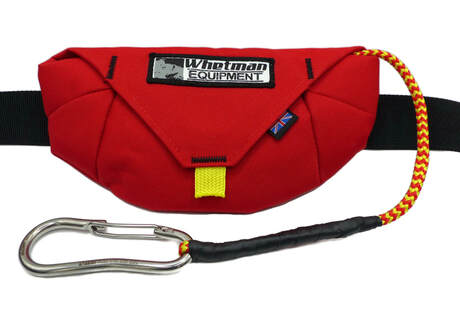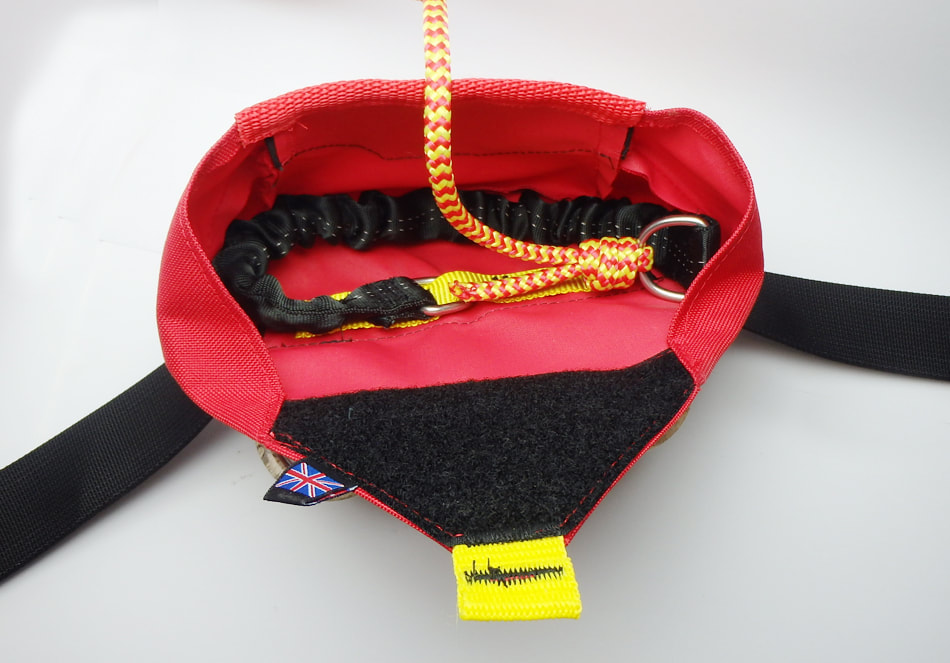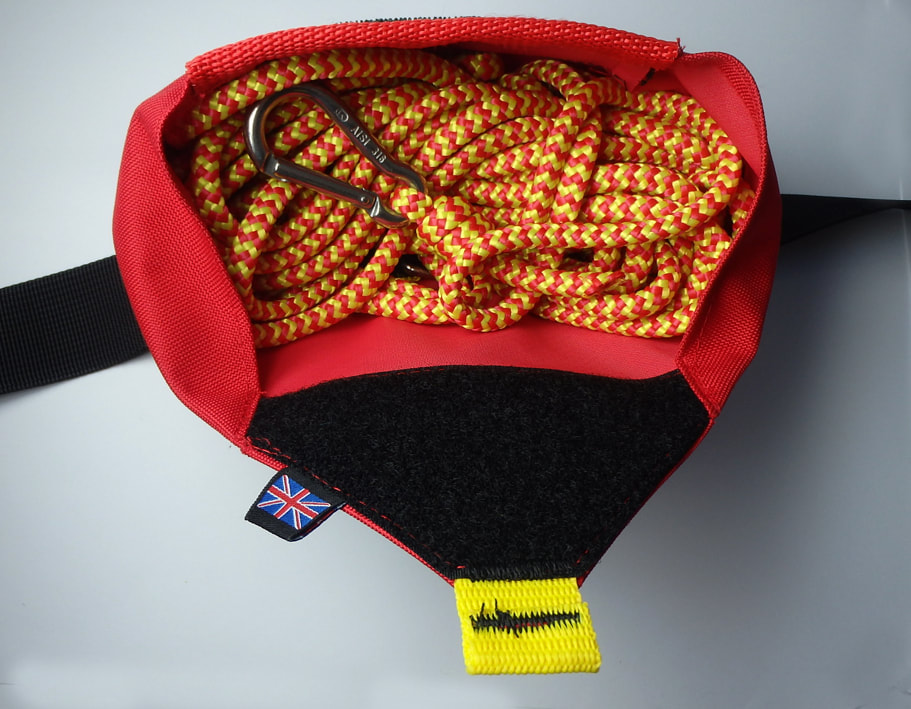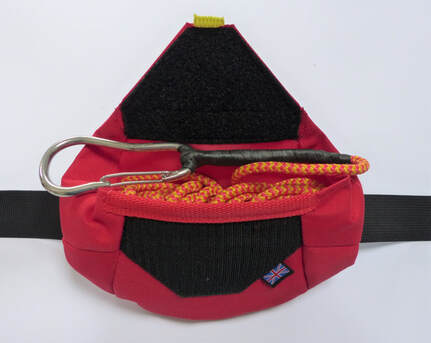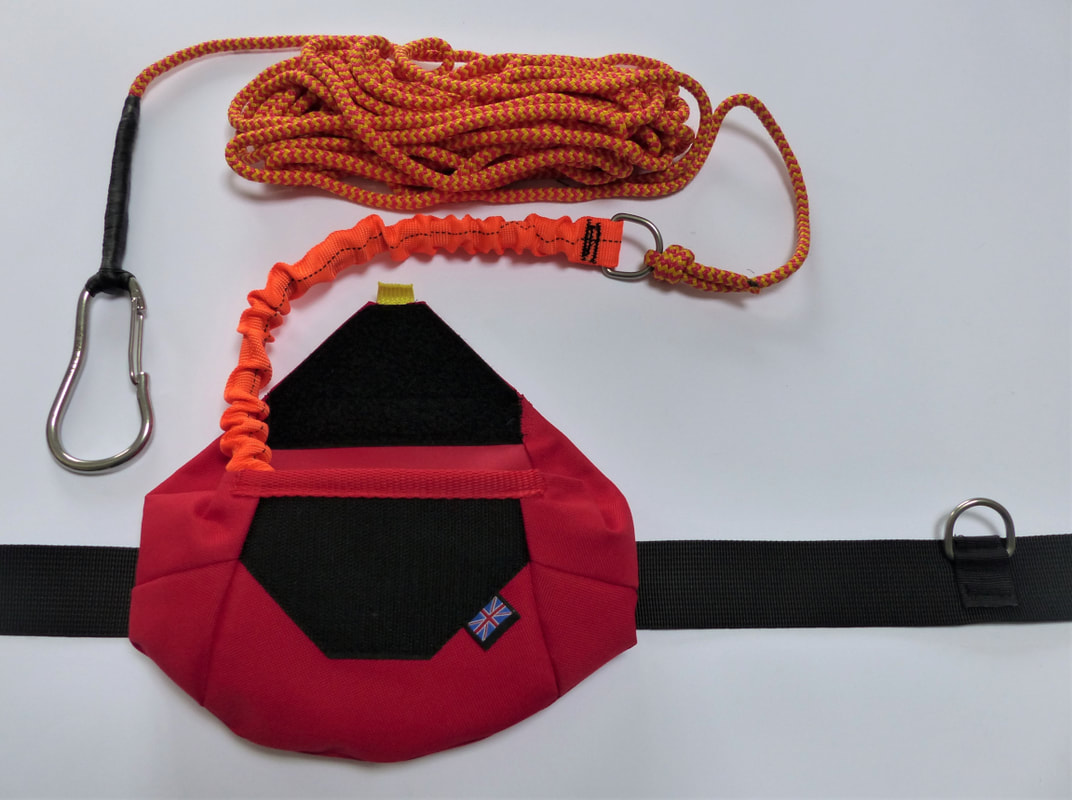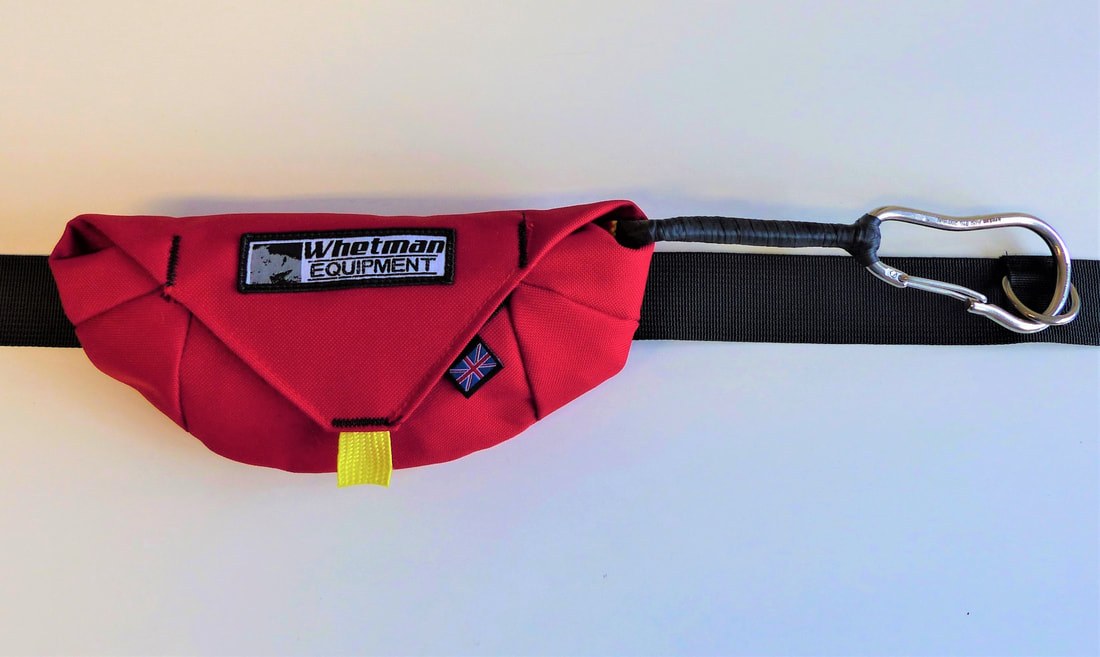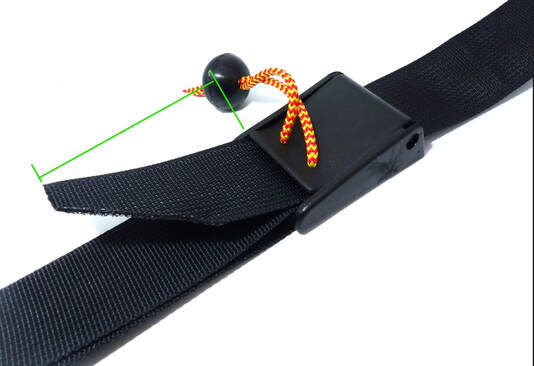|
An original Whetman Equipment designed product.
|
Sea Bean TowlineDesigned to be super compact, simple to use, mega strong yet easy to repack
How small can a sea kayak towline be and still work? Well the answer is about the size of a large Cornish pasty or Croissant or Empanada or Calzone! |
From january 2019 all new Sea Beans shall be fitted with the new Kraken sea karabiner designed by Whetman Equipment.
Connectors for Sea Kayak Towing - be informed of the characteristics of this piece of kit - read the article at the base of this page
Please note the yellow internal tab described in the video has been removed from the current specification as it was considered too fiddly to operate.
40mm belt & compact bag fits between the deck and PFD .
Options
Sea Bean Elite 10m or Sea Bean Elite 14m
Sea Bean Elite 10m or Sea Bean Elite 14m
10 metre or 14 metre floating braided line connects to a shockcord fixed into the bag.
The line is anchored to the bag using a stainless D ring, mega strong polyester webbing and high tensile bar tack stitching.
The line is anchored to the bag using a stainless D ring, mega strong polyester webbing and high tensile bar tack stitching.
|
The ergonomic panel shape assures the bag holds open to allow hands free to focus on a quick repack of the line. The yellow internal polyester webbing is anchored through the bag to bind with the 40mm waist belt using industrial bar tacks and high tensile thread. The 40mm waist belt has a quick release buckle & toggle & is adjustable to set the buckle centred in front of you for access. To close the bag the shape naturally lends itself to fold and capture the line in one simple movement. |
Sea Bean Elite
The Elite has two new aspects. The line is spliced onto the karabiner & so offers a low profile. It is also coated in rubber which wraps around the connector giving 100mm of grip extension. There is a stainless D ring to park the connector. The D ring stands proud of the webbing for ease of clipping.
How to quickly repack your towline on the water.
Belt Safety Advice
Adjust the belt length to fit your waist so that the large main quick release buckle is central in front and the towbag is aligned central to the rear. To adjust use the belt slider and also use the webbing through the main buckle. Adjust whilst wearing kit you will be using on the water. Once the belt is adjusted to fit you there will be excess webbing tailing out of the main buckle. It is highly recommended to cut the excess tail so that a very short length tail remains: tail length approx 8cm.
Adjust the belt length to fit your waist so that the large main quick release buckle is central in front and the towbag is aligned central to the rear. To adjust use the belt slider and also use the webbing through the main buckle. Adjust whilst wearing kit you will be using on the water. Once the belt is adjusted to fit you there will be excess webbing tailing out of the main buckle. It is highly recommended to cut the excess tail so that a very short length tail remains: tail length approx 8cm.
Cut the tail using sharp scissors or a hot knife. Make sure the end edge is melted and flat so there are no rough burrs. A short tail will allow a much quicker release of the belt in an emergency.
Pull and Punch
To deploy an effective quick release pull and punch forward the release toggle and with a short tail the belt will quick release.
Pull and Punch
To deploy an effective quick release pull and punch forward the release toggle and with a short tail the belt will quick release.
Connectors for Sea Kayak towing.
There are a variety of connectors used for towing sea kayaks and all have their benefits and pitfalls. There is not a perfect connector yet available for this task; each one has its limitations and it is up to the paddler to make an informed choice of what to use and then test and practise using it so as to become competent in its deployment & appreciate what it can/cannot do. This text is to assist in giving that information & we also suggest go chat to an experienced sea kayak coach!
Sea kayaking is an assumed risk activity and your rescue kit is there to help you manage that risk. However on rare occasions it may malfunction; therefore your exposure to risk should consider this & always have a back up. The connector or karabiner is a critical aspect of the sea kayak towing system. Regarding the connectors generally used they all are snag free with no hook on the nose which could snag the deckline. Most sea kayak coaches recommend clipping from underneath the deckline to reduce the chance of the clip disconnecting. All of these clips are snapgates hence they snap close on a spring and can be opened and closed very quickly; brilliant for a quick connection on a lumpy sea. This characteristic is also a potential cause of failure and can result, on rare occasions by chance, in the snapgate unclipping entirely from the deckline leaving the towed kayak at the mercy of Neptune’s wrath.
Snapgate disconnection can occur if the kayak is thrown around and lurches back and forward, up and down causing the connector & line to be tossed & twisted in all directions. With wiregate clips such as the Kraken stainless clip (and most other wiregate clips) if they run alongside the deckline on rare occasions the rope itself can catch on the gate and drag it open & disconnect. This is more prone to occur if the decklines are tight and made of cheap polypropylene rough braided lines rather than the smoother polyester decklines. So if you use these clip types practise clipping to the very front of the bow to prevent this. The benefit of wiregate clips is the spring is very simple and will not jam or corrode given it is created by eccentric loading of tensioned maintenance free stainless steel – clever stuff! Lets compare this to a connector with a solid gate. These clips have an internal tube with a traditional spring which can jam with dirt and salt crystals; so although these are less likely (still possible though) to disconnect from a line, they may jam open or closed when you need them most! Even when scrupulously maintained these clips can fail as a result of exposure to a marine environment. There are also some plastic clips used and issued on products; they are quite small & chunky with a leaf type gate and are light and relatively cheap. The maximum strength of these is much lower than a metal clip so consider what types of situations you will be in and make an informed decision. Some coaches will insist on these being replaced before launching!
In rock climbing snapgates are recognised as a risky connection and are not used for critical rigging; that task is for a screwgate connector; a threaded collar is screwed over the gate to stop it opening. The screwgate connector is another option to consider. If you intend to be in demanding high risk situations where a towline connection must be super reliable then a screwgate clip is the tool for the job. Stop! Its not that simple of course given the collar could jam with sand/salt/corrosion, and also the spring could fail, so if you decide on one of these be extremely vigilant with maintenance and lubrication.
So as yet there is no perfect connector and hopefully this information will help you decide what to use and recognise the limitations of your choice. My company is striving to develop new ideas for a more versatile connection system and we haven’t yet got the perfect design so watch this space!
Steve Whetman
Whetman Equipment
There are a variety of connectors used for towing sea kayaks and all have their benefits and pitfalls. There is not a perfect connector yet available for this task; each one has its limitations and it is up to the paddler to make an informed choice of what to use and then test and practise using it so as to become competent in its deployment & appreciate what it can/cannot do. This text is to assist in giving that information & we also suggest go chat to an experienced sea kayak coach!
Sea kayaking is an assumed risk activity and your rescue kit is there to help you manage that risk. However on rare occasions it may malfunction; therefore your exposure to risk should consider this & always have a back up. The connector or karabiner is a critical aspect of the sea kayak towing system. Regarding the connectors generally used they all are snag free with no hook on the nose which could snag the deckline. Most sea kayak coaches recommend clipping from underneath the deckline to reduce the chance of the clip disconnecting. All of these clips are snapgates hence they snap close on a spring and can be opened and closed very quickly; brilliant for a quick connection on a lumpy sea. This characteristic is also a potential cause of failure and can result, on rare occasions by chance, in the snapgate unclipping entirely from the deckline leaving the towed kayak at the mercy of Neptune’s wrath.
Snapgate disconnection can occur if the kayak is thrown around and lurches back and forward, up and down causing the connector & line to be tossed & twisted in all directions. With wiregate clips such as the Kraken stainless clip (and most other wiregate clips) if they run alongside the deckline on rare occasions the rope itself can catch on the gate and drag it open & disconnect. This is more prone to occur if the decklines are tight and made of cheap polypropylene rough braided lines rather than the smoother polyester decklines. So if you use these clip types practise clipping to the very front of the bow to prevent this. The benefit of wiregate clips is the spring is very simple and will not jam or corrode given it is created by eccentric loading of tensioned maintenance free stainless steel – clever stuff! Lets compare this to a connector with a solid gate. These clips have an internal tube with a traditional spring which can jam with dirt and salt crystals; so although these are less likely (still possible though) to disconnect from a line, they may jam open or closed when you need them most! Even when scrupulously maintained these clips can fail as a result of exposure to a marine environment. There are also some plastic clips used and issued on products; they are quite small & chunky with a leaf type gate and are light and relatively cheap. The maximum strength of these is much lower than a metal clip so consider what types of situations you will be in and make an informed decision. Some coaches will insist on these being replaced before launching!
In rock climbing snapgates are recognised as a risky connection and are not used for critical rigging; that task is for a screwgate connector; a threaded collar is screwed over the gate to stop it opening. The screwgate connector is another option to consider. If you intend to be in demanding high risk situations where a towline connection must be super reliable then a screwgate clip is the tool for the job. Stop! Its not that simple of course given the collar could jam with sand/salt/corrosion, and also the spring could fail, so if you decide on one of these be extremely vigilant with maintenance and lubrication.
So as yet there is no perfect connector and hopefully this information will help you decide what to use and recognise the limitations of your choice. My company is striving to develop new ideas for a more versatile connection system and we haven’t yet got the perfect design so watch this space!
Steve Whetman
Whetman Equipment

